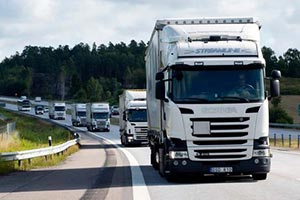European Truck Platooning Challenge Nears Completion of Goal

The European Truck Platooning Challenge is scheduled to conclude April 6 at the Port of Rotterdam, when six platoons of two trucks each arrive at the APM terminal there, according to organizers.
European truck makers are pushing for the adoption of fuel-saving platooning technology that allows several trucks to automatically drive closely to each other.
As part of that push, several manufacturers are taking part in the platooning challenge with the aim of moving a step closer to allowing the fuel-saving technology on roads.
Three Volvo trucks started a platoon demonstration drive from Gothenburg, Sweden, to Rotterdam, Netherlands, on March 18, Volvo Group said.
“We believe that platooning offers major advantages, mainly for our customers, but also for society in the form of fuel savings, reduced emissions and enhanced transportation efficiency," Anders Kellström, project manager for Volvo’s participation in the challenge, said in a statement. "Together with the rest of society, the transportation industry needs to tackle such challenges as the harmonization of legislation.”
Daimler Trucks recently demonstrated a three-truck platoon on the autobahn as part of an event to spotlight the growing importance of connectivity. During the demonstration, as cars cut in between the trucks, the trucks automatically altered their distances until the path was clear again.
PHOTO GALLERY: Scenes from Daimler's Platoon Demonstration
Daimler has been at the forefront of self-driving truck proponents, citing improvements in driver safety and fuel efficiency while predicting the technology will overcome legal hurdles in road freight transport.
Volkswagen's truck division will spend about half a billion euros by the end of the decade to enhance digital features of heavy-goods vehicles as truck makers increase their focus on automation in road haulage, VW said on April 4.
It currently is not possible to use the technology on Europe’s roads because legislation differs among countries on what is a safe driving distance between trucks.
For the platooning challenge, trucks have been given special permission to deploy wireless communication, thereby enabling them to halve distances to 0.5 seconds between vehicles.
The Scania contingent in the 2016 European Truck Platooning Challenge reached Belgium on April 1 for a demonstration at a race track, near Brussels. Embarking from Scania’s Head Office in Sodertalje, the three-truck wirelessly connected Scania platoon has travelled through Sweden, Denmark and Germany before reaching Belgium, the company said in a statement.
Volkswagen, which started to beef up its truck operations before its car emissions scandal broke last September, is pushing digitalization and new mobility technologies as part of efforts to reposition itself and overcome the scandal.
VW's truck and bus group said it would spend a "mid-range three-digit million-euro amount" over the next five years on digital features as it aims to improve communication of onboard sensors with automatic braking and other systems.
MAN, part of VW's trucks division with Swedish subsidiary Scania, has said platooning could help reduce diesel consumption and carbon dioxide emissions in road freight transport by as much as 10%.
"The future truck is fully connected, that provides a gain in safety and efficiency," VW trucks chief Andreas Renschler said.
However, investment in infrastructure needs to keep pace for some of the new technology to work.
"In future it will no longer be enough to build roads and repair bridges," Renschler said. "What we need as quickly as possible is mobile high-speed internet alongside the road."

